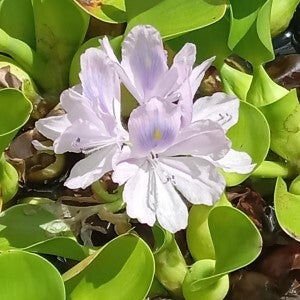Water hyacinth (Eichhornia crassipes) is a beautiful aquatic plant known for its vibrant green leaves and striking purple flowers. However, it is not uncommon for water hyacinth to turn yellow, which can be a cause for concern among gardeners, environmentalists, and those who appreciate the plant’s aesthetic value. In this post, we will explore the reasons behind the yellowing of water hyacinth and discuss potential solutions to mitigate this issue.
Causes of Yellowing:
1. Nutrient Deficiency:
The main reason for the yellowing of water hyacinth is a deficiency in essential nutrients. Like all plants, water hyacinth requires a balanced supply of nutrients, including nitrogen, phosphorus, and potassium, for healthy growth. These nutrients need to be dissolved into the water where the water hyacinth is living. Insufficient levels of these nutrients can lead to chlorosis, a condition characterized by yellowing leaves due to a lack of chlorophyll production. Some people have been known to remedy the nutrient deficiency by taking the water hyacinth out the pond and placing it into a bucket of fertilizer water for a week. A more organic solution might be to overfeed the fish in the pond, or to cautiously add manure to the pond water.
To address nutrient deficiencies, it is essential to provide water hyacinth with a balanced supply of nutrients. This can be achieved by using slow-release fertilizers specifically formulated for aquatic plants. Regularly monitoring nutrient levels and adjusting fertilizer application accordingly can help maintain optimal nutrient balance and prevent yellowing.
2. Light Intensity:
Water hyacinth thrives in full sunlight, as it is a light-loving plant. However, excessive exposure to intense sunlight can cause the leaves to turn yellow. This phenomenon, known as sunburn, occurs when the plant’s photosynthetic pigments are damaged by excessive light energy, leading to a reduction in chlorophyll production.
To prevent sunburn, it is crucial to provide water hyacinth with the right amount of light. If the plant is exposed to intense sunlight for extended periods, providing shade or relocating it to a partially shaded area can help protect the leaves from excessive light energy. This will help maintain healthy chlorophyll production and prevent yellowing.
3. Water Quality:
The quality of the water in which water hyacinth grows plays a crucial role in its overall health. Poor water quality, such as high levels of pollutants or heavy metals, can negatively impact the plant’s ability to absorb nutrients and carry out photosynthesis effectively. As a result, the leaves may turn yellow as a sign of stress or damage.
Maintaining good water quality is vital for the health of water hyacinth. Regular testing of water parameters, such as pH, dissolved oxygen, and nutrient levels, can help identify and address any issues. Implementing appropriate water treatment methods, such as filtration or the use of beneficial bacteria, can help improve water quality and prevent yellowing.
4. Temperature Stress:
Water hyacinth is a tropical plant that thrives in warm climates. Exposure to extreme temperatures, especially cold temperatures, can cause the leaves to turn yellow. Cold stress disrupts the plant’s metabolic processes, impeding nutrient uptake and photosynthesis, ultimately leading to leaf discoloration. If the pond water is getting too warm, water hyacinth will turn yellow, stop growing, and slowly die out. To prevent the water from getting too warm you should be sure to always build ponds as deep as you can afford to make it, and then keep the water level topped off.
To protect water hyacinth from temperature stress, it is important to ensure that the plant is not exposed to extreme cold or hot temperatures. In colder climates, providing insulation or moving the plant indoors during winter can help prevent yellowing due to cold stress. Similarly, in hot climates, providing shade or using evaporative cooling techniques can help maintain optimal temperatures for the plant’s growth.
Water hyacinth turning yellow can be a sign of various underlying issues, including nutrient deficiencies, light intensity problems, water quality problems, and temperature stress. By understanding these causes and implementing appropriate solutions, we can help maintain the health and vibrancy of water hyacinth. Regular monitoring, nutrient management, light regulation, water quality management, and temperature control are key factors in preventing yellowing and ensuring the longevity of this beautiful aquatic plant. Let us strive to strike a balance that allows us to enjoy the beauty of water hyacinth while preserving the health of our aquatic ecosystems.
